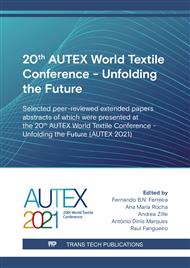[1]
D. M. Hulett, M. Benedick, S. Y. Thomas, and F. Moccio, A National Report Card on Women in Firefighting, (2008).
Google Scholar
[2]
L. M. Boorady, J. Barker, Y. A. Lee, S. H. Lin, E. Cho, and S. P. Ashdown, Exploration of Firefighter Turnout Gear Part 1: Identifying Male Firefighter User Needs, J. Text. Apparel, Technol. Manag. 8, 1 (2013).
Google Scholar
[3]
A. Coca, R. Roberge, A. Shepherd, J. B. Powell, J. O. Stull, and W. J. Williams, Ergonomic Comparison of a Chem/Bio Prototype Firefighter Ensemble and a Standard Ensemble, Eur. J. Appl. Physiol. 104, 351 (2008).
DOI: 10.1007/s00421-007-0644-z
Google Scholar
[4]
A. Coca, W. J. Williams, R. J. Roberge, and J. B. Powell, Effects of Fire Fighter Protective Ensembles on Mobility and Performance, Appl. Ergon. 41, 636 (2010).
DOI: 10.1016/j.apergo.2010.01.001
Google Scholar
[5]
P. Hasenmeier, The History of Firefighter Personal Protective Equipment, Fire Eng. (2008).
Google Scholar
[6]
H. Park and K. H. Y. Hahn, Perception of Firefighters Turnout Ensemble and Level of Satisfaction by Body Movement, Int. J. Fash. Des. Technol. Educ. 7, 85 (2014).
DOI: 10.31274/itaa_proceedings-180814-908
Google Scholar
[7]
H. Fake, Women in Fire, https://discoversawtooth.org/women-in-fire.
Google Scholar
[8]
R. McCoppin, A. L. Lourgos, and A. Fabbre, Female Firefighters Strive for Equality, Chicago Trib. (2018).
Google Scholar
[9]
B. Evarts and G. P. Stein, US Fire Department Profile 2018, (2020).
Google Scholar
[10]
Statistics Portugal - Instituto Nacional de Estatística (INE), Firemen (No.) by Geographic Localization (NUTS-2013), Sex, Age Group and Type of Link.
Google Scholar
[11]
New Statistics Show an Increase in Female Firefighters, https://www.nationalfirechiefs.org.uk/News/new-statistics-show-an-increase-in-female-firefighters.
Google Scholar
[12]
T. Konguavi, Edmonton Firefighting Camp Aims to Recruit More Women, Gender Diverse People to City's Service, https://www.cbc.ca/news/canada/edmonton/camp-inspire-fire-services-1.6182096.
Google Scholar
[13]
H. Liao, R. D. Arvey, R. J. Butler, and S. M. Nutting, Correlates of Work Injury Frequency and Duration among Firefighters, J. Occup. Health Psychol. 6, 229 (2001).
DOI: 10.1037/1076-8998.6.3.229
Google Scholar
[14]
M. McQuerry, C. Kwon, and H. Johnson, A Critical Review of Female Firefighter Protective Clothing and Equipment Workplace Challenges, Res. J. Text. Appar. 23, 94 (2019).
DOI: 10.1108/rjta-01-2019-0002
Google Scholar
[15]
J. Park and K. Langseth-Schmidt, Anthropometric Fit Evaluation of Firefighters' Uniform Pants: A Sex Comparison, Int. J. Ind. Ergon. 56, 1 (2016).
DOI: 10.1016/j.ergon.2016.08.011
Google Scholar
[16]
K. Langseth-Schmidt, Anthropometric Fit Evaluation of Structural Firefighters' Protective Pants: A Gender Comparision Study, Colorado State University, (2014).
Google Scholar
[17]
N. Nawaz and O. Troynikov, Firefighters' Protective Jackets: Fit to Female Form and Its Effects on Attributes Relevant to Thermal Comfort, J. Occup. Environ. Hyg. 15, 792 (2018).
DOI: 10.1080/15459624.2018.1506587
Google Scholar
[18]
K. Sinden, J. MacDermid, S. Buckman, B. Davis, T. Matthews, and C. Viola, A Qualitative Study on the Experiences of Female Firefighters, Work 45, 97 (2013).
DOI: 10.3233/wor-121549
Google Scholar
[19]
H. Hsiao, D. Long, and K. Snyder, Anthropometric Differences among Occupational Groups, Ergonomics 45, 136 (2002).
DOI: 10.1080/00140130110115372
Google Scholar
[20]
H. Hsiao, J. Whitestone, T. Y. Kau, R. Whisler, J. G. Routley, and M. Wilbur, Sizing Firefighters: Method and Implications, Hum. Factors 56, 873 (2014).
DOI: 10.1177/0018720813516359
Google Scholar
[21]
P. T. X. Parceria PPS4, Requisitos Do Utilizador – Proteção Ao Fogo, (2012).
Google Scholar
[22]
V. I. R. Veiga, Condições de Satisfação Com o Uso de Equipamento de Proteção Individual (EPI) No Combate a Incêndios Urbanos e Florestais Por Bombeiros No Distrito de Bragança, Polytechnic Institute of Bragança, (2019).
Google Scholar
[23]
H. Hsiao, D. Weaver, J. Hsiao, J. Whitestone, T. Y. Kau, R. Whisler, and R. Ferri, Comparison of Measured and Self-Reported Anthropometric Information among Firefighters: Implications and Applications, Ergonomics 57, 1886 (2014).
DOI: 10.1080/00140139.2014.952351
Google Scholar
[24]
N. Zakaria and D. Gupta, Apparel Sizing: Existing Sizing Systems and the Development of New Sizing Systems, in Anthropometry, Apparel Sizing and Design, edited by D. Gupta and N. Zakaria (Woodhead Publishing, Cambridge, 2014), p.3–33.
DOI: 10.1533/9780857096890.1.3
Google Scholar
[25]
NC170: Personal Protective Technologies for Current and Emerging Occupational and Environmental Hazards, https://www.nimss.org/projects/18359.
Google Scholar
[26]
T. G. Lohman, A. F. Roche, and R. Martorell, editors , Anthropometric Standardization Reference Manual - Abridged Edition (Human Kinetics Books, Champaign, 1991).
DOI: 10.1002/ajhb.1310040323
Google Scholar
[27]
International Organization for Standardization, EN-ISO 15535:2012 - General Requirements for Establishing Anthropometric Databases, (2014).
Google Scholar
[28]
M. P. Barroso, P. M. Arezes, L. G. Da Costa, and A. S. Miguel, Anthropometric Study of Portuguese Workers, Int. J. Ind. Ergon. 35, 401 (2005).
DOI: 10.1016/j.ergon.2004.10.005
Google Scholar
[29]
P. M. Arezes, M. P. Barroso, P. Cordeiro, L. G. Da Costa, and A. S. Miguel, Estudo Antropométrico Da População Portuguesa, Segurança (ISHST - Inst. para a Segurança, Higiene e Saúde no Trabalho, Lisboa, 2006).
Google Scholar
[30]
R. Poínhos, B. Franchini, C. Afonso, F. Correia, V. H. Teixeira, P. Moreira, C. Durão, O. Pinho, D. Silva, J. P. Lima Reis, T. Veríssimo, and M. D. V. De Almeida, Alimentação e Estilos de Vida Da População Portuguesa: Metodologia e Resultados Preliminares, Rev. Aliment. Humana 15, 43 (2009).
DOI: 10.1016/j.rpsp.2016.06.004
Google Scholar
[31]
Ministry of Internal Administration - Ministério da Administração Interna, Decree-Law No. 247/2007 of 27 of June - Decreto-Lei No. 247/2007 de 27 de Junho - Ministério Da Administração Interna (Portugal, 2007).
Google Scholar
[32]
S. Pheasant and C. M. Haslegrave, Bodyspace: Anthropometry, Ergonomics and the Design of Work, 3rd Editio (CRC Press - Taylor & Francis Group, Boca Raton, 2006).
DOI: 10.1177/106480460701500210
Google Scholar
[33]
A. S. P. Moraes, M. A. Carvalho, R. S. Boldt, F. N. Ferreira, S. P. Ashdown, and L. Griffin, Portuguese Firefighters Anthropometrics: A Preliminary Comparison with Portuguese Workers, in Advances in Ergonomics in Design. AHFE 2021. (2021), p.33–41.
DOI: 10.1007/978-3-030-79760-7_5
Google Scholar



